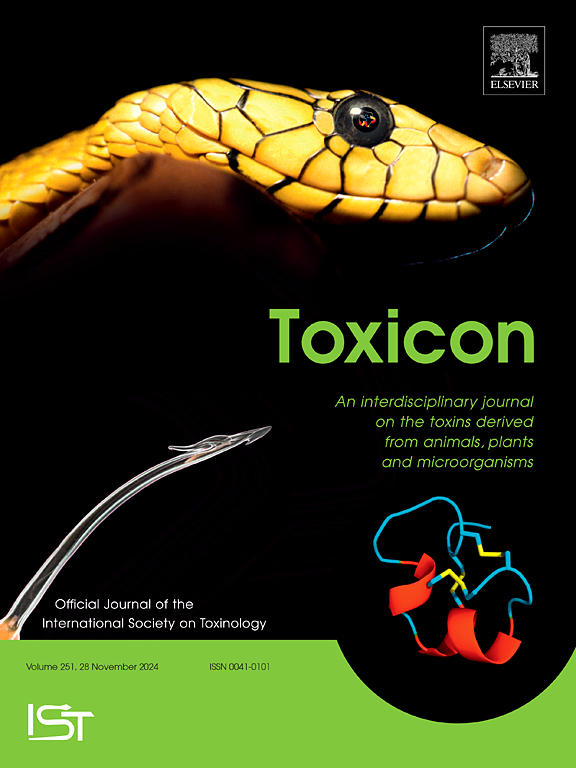Identification of effective inhibitors against epsilon toxin (ETX) of Clostridium perfringens: Virtual screening and molecular dynamics simulation
IF 2.6
4区 医学
Q2 PHARMACOLOGY & PHARMACY
引用次数: 0
Abstract
In spite of the potential for toxicity in humans, no therapeutics are approved against Epsilon toxin (ETX) for human use. Therefore, finding effective inhibitors for this toxin has garnered a lot of attention. In this regard, we performed an in silico study to find effective inhibitors against this toxin. To this end, the structure of ETX and an experimentally approved ETX inhibitor were prepared and docked as a control interaction and used for the determination of the binding site. An approved library of small molecules was obtained from the DrugBank database and prepared for virtual screening via size filtering and the addition of conformations. The top five molecules with the highest binding energy were used to draw their 2D interaction plots against ETX. A 100 ns MD simulation was performed on the Antrafenine-ETX complex as the best result of the screening stage in comparison to the control complex. The obtained results showed that among the 3849 molecules (which were analyzed by virtual screening), Cefotiam, Antrafenine, Ferric Derisomaltose, Mupirocin, and Salmeterol had the highest binding energies (binding energies respectively calculated to be −5.6, −5.8, −4.9, −4.9, and −4.6 kcal/mol). The 2D interaction plots also showed that the screened molecules had stronger interacting bonds with the ETX protein. MD simulations showed that the Antrafenine-ETX complex has a similar RMSD plot to the control complex, while its RMSF, hydrogen bond, and GR plots show better results for the Antrafenine-ETX complex. In light of these results, Antrafenine could be the best choice for ETX inhibition regarding strength, while based on the route of administration and drug applications, Cefotiam could also be considered for ETX inhibition. It seems that despite the promising results of the performed in silico studies, further empirical pieces of evidence would strengthen these conclusions in future studies.
产气荚膜梭菌epsilon毒素有效抑制剂的鉴定:虚拟筛选和分子动力学模拟
尽管Epsilon毒素对人体有潜在的毒性,但目前尚无针对Epsilon毒素(ETX)的治疗药物被批准用于人体。因此,寻找这种毒素的有效抑制剂已经引起了很多关注。在这方面,我们进行了一项计算机研究,以找到对抗这种毒素的有效抑制剂。为此,我们制备了ETX的结构和实验认可的ETX抑制剂,并将其作为对照相互作用进行对接,用于确定结合位点。从DrugBank数据库中获得一个经批准的小分子文库,并通过大小过滤和添加构象进行虚拟筛选。利用结合能最高的前5个分子绘制其与ETX的二维相互作用图。与对照复合物相比,筛选阶段的最佳结果是对Antrafenine-ETX复合物进行了100 ns MD模拟。结果表明,在3849个虚拟筛选分子中,Cefotiam、Antrafenine、Ferric Derisomaltose、Mupirocin和salmetol的结合能最高(分别为- 5.6、- 5.8、- 4.9、- 4.9和- 4.6 kcal/mol)。二维相互作用图还显示,筛选的分子与ETX蛋白具有更强的相互作用键。MD模拟表明,Antrafenine-ETX配合物的RMSD图与对照配合物相似,而RMSF图、氢键图和GR图显示,Antrafenine-ETX配合物的结果更好。综上所述,从抑制ETX的强度来看,安曲宁是最佳选择,而根据给药途径和用药情况,头孢替安也可考虑抑制ETX。似乎尽管在计算机研究中取得了令人鼓舞的结果,但进一步的实证证据将在未来的研究中加强这些结论。
本文章由计算机程序翻译,如有差异,请以英文原文为准。
求助全文
约1分钟内获得全文
求助全文
来源期刊

Toxicon
医学-毒理学
CiteScore
4.80
自引率
10.70%
发文量
358
审稿时长
68 days
期刊介绍:
Toxicon has an open access mirror Toxicon: X, sharing the same aims and scope, editorial team, submission system and rigorous peer review. An introductory offer Toxicon: X - full waiver of the Open Access fee.
Toxicon''s "aims and scope" are to publish:
-articles containing the results of original research on problems related to toxins derived from animals, plants and microorganisms
-papers on novel findings related to the chemical, pharmacological, toxicological, and immunological properties of natural toxins
-molecular biological studies of toxins and other genes from poisonous and venomous organisms that advance understanding of the role or function of toxins
-clinical observations on poisoning and envenoming where a new therapeutic principle has been proposed or a decidedly superior clinical result has been obtained.
-material on the use of toxins as tools in studying biological processes and material on subjects related to venom and antivenom problems.
-articles on the translational application of toxins, for example as drugs and insecticides
-epidemiological studies on envenoming or poisoning, so long as they highlight a previously unrecognised medical problem or provide insight into the prevention or medical treatment of envenoming or poisoning. Retrospective surveys of hospital records, especially those lacking species identification, will not be considered for publication. Properly designed prospective community-based surveys are strongly encouraged.
-articles describing well-known activities of venoms, such as antibacterial, anticancer, and analgesic activities of arachnid venoms, without any attempt to define the mechanism of action or purify the active component, will not be considered for publication in Toxicon.
-review articles on problems related to toxinology.
To encourage the exchange of ideas, sections of the journal may be devoted to Short Communications, Letters to the Editor and activities of the affiliated societies.
 求助内容:
求助内容: 应助结果提醒方式:
应助结果提醒方式:


